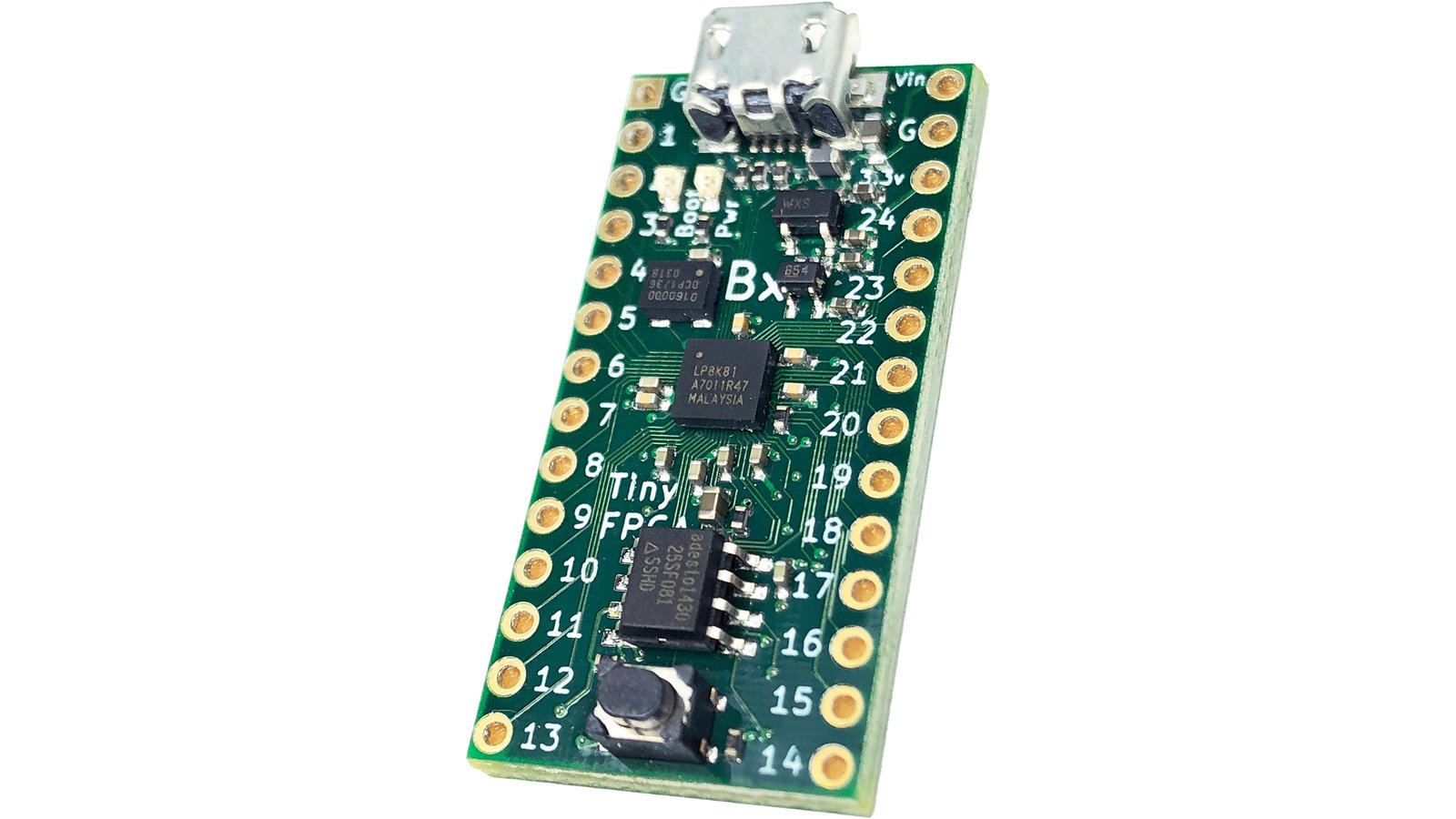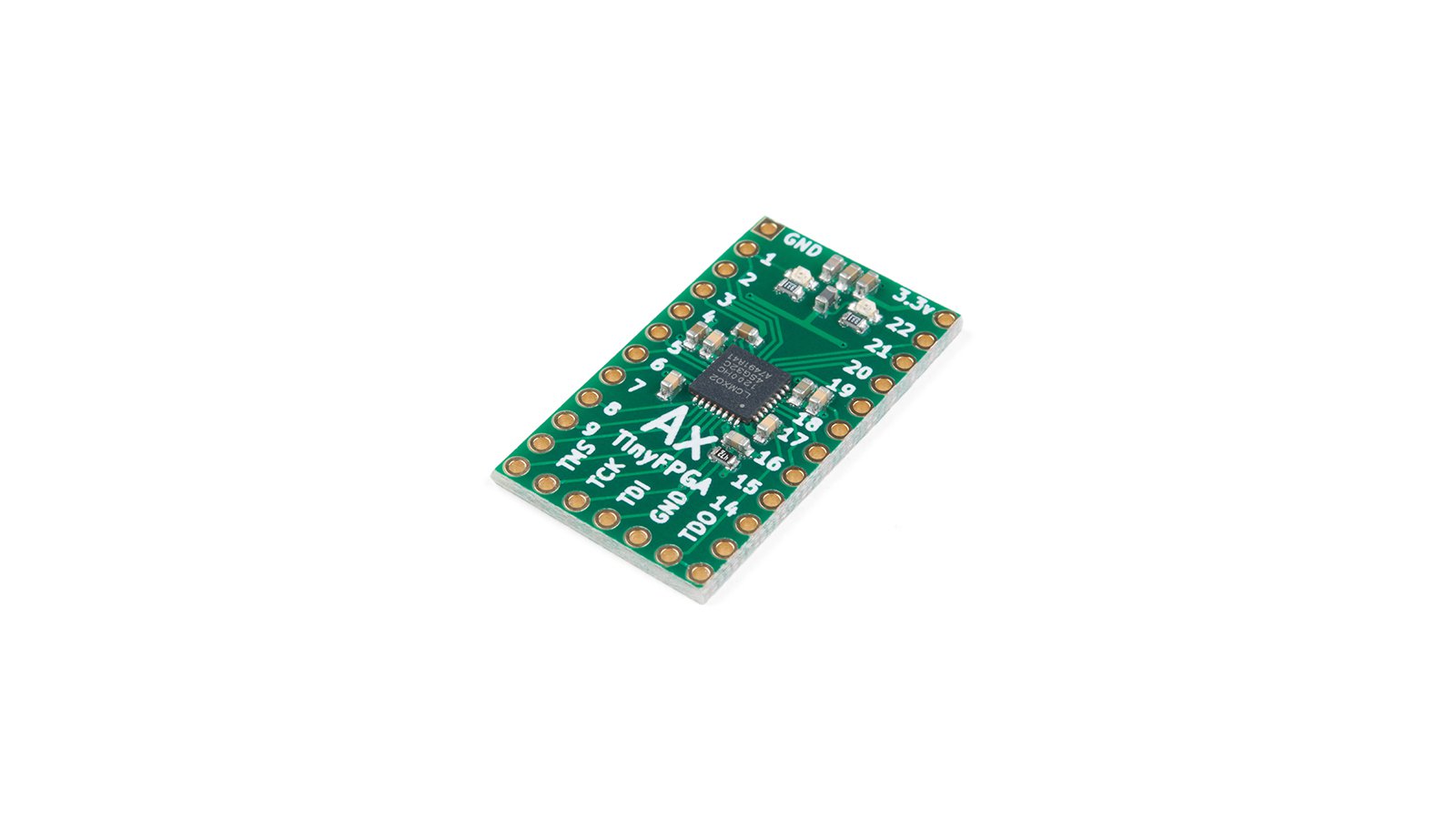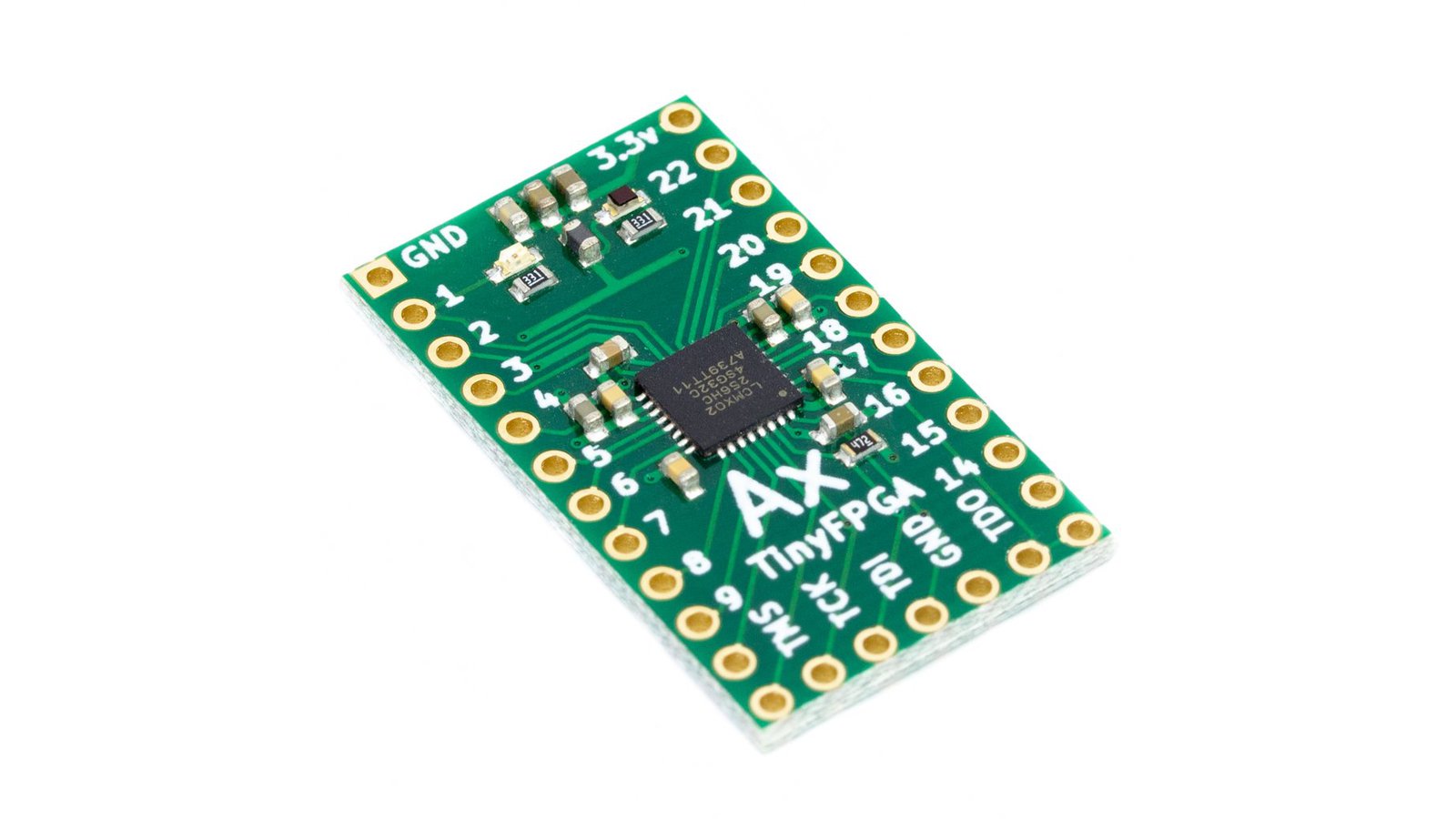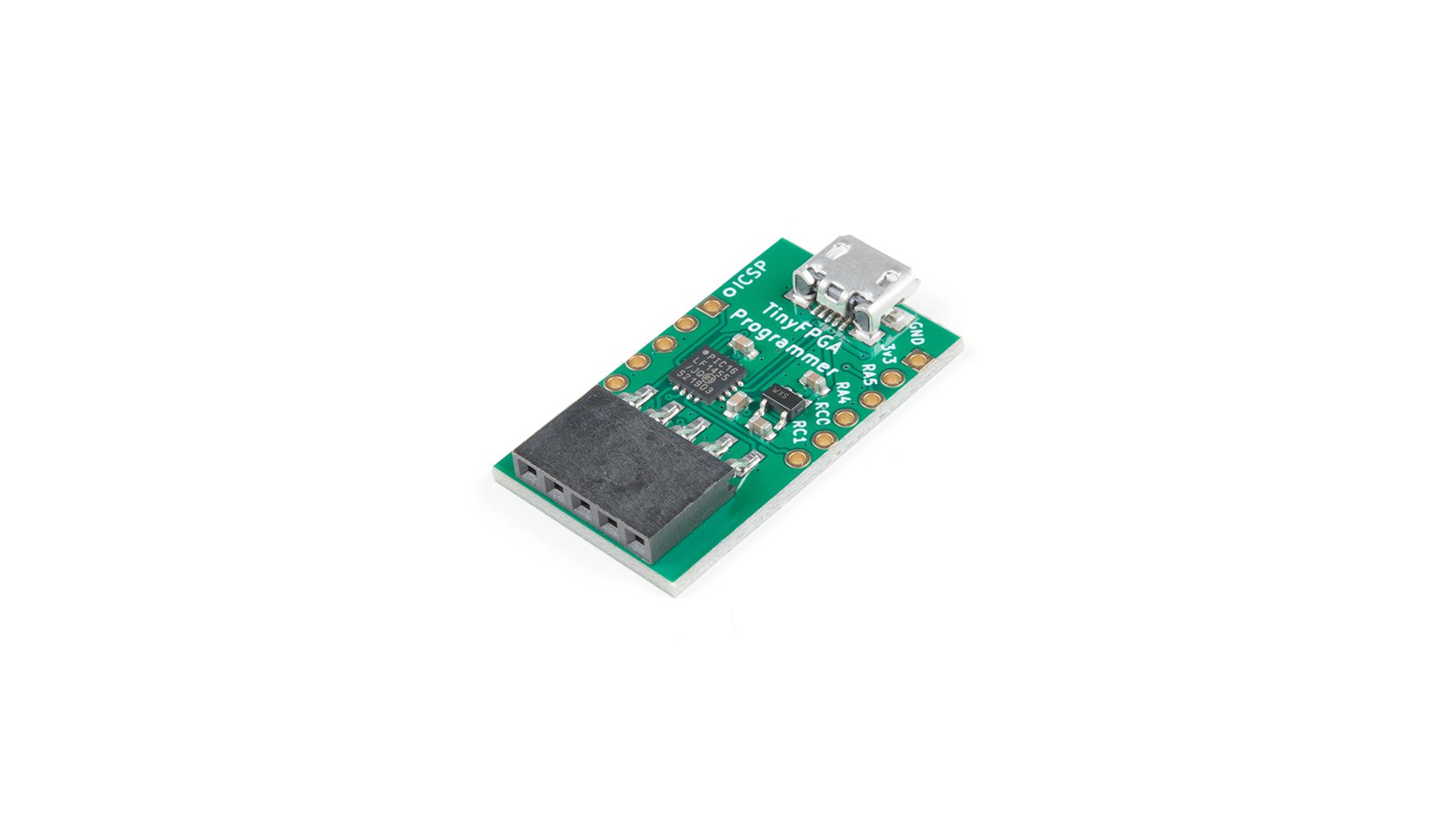The TinyFPGA BX brings the power and flexibility of custom digital logic designs to the maker community. The BX module allows you to design and implement your own digital logic circuits in a tiny form-factor perfect for breadboards, small spaces, or custom PCBs.
This incredible power allows you to do things that are not possible with traditional microcontrollers. While microcontroller boards have a fixed set of peripheral devices on-board, the TinyFPGA BX modules can implement the exact peripheral devices needed to get the job done. It’s not software bit-banging, it’s the real deal implemented in digital logic. When the next project has different requirements, reprogram the TinyFPGA BX with a new design suited to the task.
The full potential of programmable logic devices allows for even more ambitious projects than custom microcontroller peripherals: augment a retro-computer with new capabilities, recreate an 8-bit computer from history, or design your own.
If you don’t know what the big deal is with custom digital logic, then here’s a great way to learn. Place a TinyFPGA BX down on a breadboard and get to work interfacing it with LEDs, switches, rotary encoders, and any other peripheral, sensor, or interface you might like to try. The low cost of the BX and open-source ecosystem make this an excellent way to get started on a new adventure with digital logic.
Whether you are a hobbyist looking to expand your capabilities, a professional prototyping a new product, or a student learning the ropes of digital design, the TinyFPGA BX can help you on your way.
Have you ever wanted to use an FPGA in a project, but the available boards were too big or expensive? New to FPGAs and want to learn how to use them? Want to put an FPGA on a PCB you are designing but don’t want to worry about power delivery, clocking, configuration flash, or difficult surface mount packages? If you answered "yes" to any of these questions, then the TinyFPGA BX can help!
The TinyFPGA BX is designed for makers and hobbyists. It puts you in control by taking care of FPGA support details and getting out of your way. It provides an easy to use component for your projects. It’s small enough to fit comfortably on a breadboard for learning or prototyping. When you’re ready, you can design a custom PCB incorporating a TinyFPGA BX module.
The TinyFPGA BX module is completely open hardware and open source. If you move beyond the need for through-hole components, you may decide you want to re-use or adapt the design for your own creations.
The TinyFPGA BX is a small FPGA module with all of the components and circuitry required for the FPGA to function taken care of for you. To develop for the board you create a design in your favorite digital design language (Verilog/VHDL, Migen, and Chisel are some popular options). Alternatively, you can use a schematic entry tool like IceStudio. A schematic entry tool allows you to graphically draw a digital circuit to be implemented on the FPGA.
Once you have a design, you can program it onto the TinyFPGA BX module over USB. All the functions your design implements will now be able to interface with the outside world through the module’s IO pins.
There’s plenty of space on either side for connecting jumpers or components. There is no smaller FPGA board available with this many logic resources!
Forget proprietary and expensive USB interface chips, the TinyFPGA BX implements its own open source USB bootloader! Upon power-up, USB bootloader is loaded from SPI flash and becomes active. It appears on the host computer as a virtual serial port device. The programmer software automatically detects the board and uses the serial interface to program your design onto the board. Once your design is loaded in the SPI flash, the board reboots and loads your design without the bootloader. To update your design just press the reset button and the bootloader will be activated again.
The TinyFPGA Bootloader has features that proprietary chips do not have. In addition to lowering the cost of the board for users like you, it also contains metadata on the SPI flash in an open JSON format. This metadata contains:
This metadata, along with the dedicated programmer tool, makes the TinyFPGA BX boards easy to use.
If you want to see all the metadata stored on all the boards connected, you can get a full JSON listing of the metadata annotated with the serial port name they are connected to.
For technical details and source code see the TinyFPGA Bootloader GitHub repository.
The TinyFPGA BX improves upon the previous B2 model in every aspect and the PCB layout is no exception. In addition to nearly doubling the number of user IOs, the new PCB layout also an improved PCB layout and power delivery:
In addition to the free tools from Lattice for developing with the iCE40 FPGAs, the TinyFPGA BX is also supported by the completely open-source IceStorm FPGA toolchain.
IceStorm has enabled incredible tools like IceStudio to be developed. If you are new to the world of digital logic, IceStudio is a great way to learn and make with FPGAs.
IceStorm currently supports the TinyFPGA B2 and I will be working closely with its creators to implement support for the TinyFPGA BX as well.
If graphical schematic entry is not your thing, you can use your own favorite text editor or try out the APIO-IDE project. APIO-IDE builds on top of PlaformIO-IDE and is a great open-source development environment for FPGAs.
Besides the TinyFPGA BX, there are a few different FPGA boards that have adopted a smaller form factor suitable for breadboards. These boards vary in availability, price, capacity, features, and license. A section on FPGA power delivery comparisons has been added since it is easy to overlook and can have a large impact on stability and signal integrity.
| TinyFPGA BX | Lattice ICEstick | UPDuino v2.0 | bugblat TIF | |
|---|---|---|---|---|
| License | OSHW | Closed | Closed | Closed |
| Stock | Pre-Order | In Stock | In Stock | Out of Stock |
| FPGA | ||||
| Model | iCE40LP8K | iCE40HX1K | iCE40UP5 | LCMX02 1200/4000 |
| Logic Capacity (LUTs) | 7680 | 1280 | 5280 | 1280/4320 |
| Internal RAM (bits) | 128k | 64k | 120k + 1024k | 64k/92k |
| Multipliers | 0 | 0 | 8 | 0/0 |
| Peripherals | ||||
| USB Interface | OSHW Bootloader | FTDI 2232HL | FTDI 232HQ | SIL 2112 |
| User IOs | 41 | 24 | 34 | 16 |
| Onboard Clock | 16 MHz MEMS | 12 MHz MEMS | 12 MHz (from FTDI) | 48 MHz (from SIL) |
| Flash | 8 MBit SPI Flash | 32 MBit SPI Flash | 32 MBit SPI Flash | 80KBit/96KBit FPGA User Flash |
| FPGA Power Delivery | ||||
| Dedicated Ground/Power Planes | Yes | Yes | No | Yes |
| Dedicated FPGA Bypass Capacitors | 8 | 18 | 2 | 4 |
| Board Ground Connections | 6 | 6 | 3 | 3 |
| Software | ||||
| Open Source Toolchain | Yes | Yes | Yes | No |
| APIO Support | Yes | Yes | No | No |
| IceStudio Support | Yes | Yes | No | No |
| TinyFPGA AX1 | TinyFPGA AX2 | |||
|---|---|---|---|---|
| FPGA Chip | XO2-256 | XO2-1200 | ICE40LP8K | LFE5U-25F |
| Programming Interface | JTAG | JTAG | USB | USB |
| Logic Cells | 256 | 1200 | 7680 | 24288 |
| Distributed RAM | 2 KBit | 10 KBit | 194 KBit | |
| Block RAM | 64 KBit | 128 KBit | 1008 KBit | |
| User Flash | 64 KBit | 6000 KBit | 96000 KBit | |
| Phase Lock Loops | 1 | 1 | 2 | |
| Delay Lock Loops | 2 | |||
| User IO Pins (dedicated + shared) | 18 + 4 | 18 + 4 | 31 + 10 | 49 + 7 |
The TinyFPGA AX1 board is a bare-bones breakout board for the Lattice MachXO2-256 FPGA.
See the TinyFPGA A-Series User Guide for all the information you need to get your FPGA project up and running.
The TinyFPGA AX2 board is a bare-bones breakout board for the XO2-1200 FPGA. This is a much more powerful board than the AX1 with nearly 5 times as many digital logic resources, 64 kilobits of dedicated RAM, 64 kilobits of user flash memory, and a PLL in addition to the features of the AX1.
See the TinyFPGA A-Series User Guide for all the information you need to get your FPGA project up and running.
One of the goals of the TinyFPGA boards is to make FPGAs cheaper to use. The TinyFPGA AX1 and TinyFPGA AX2 boards are the first TinyFPGA boards and are designed to be the least expensive. As such, they do not include a built-in USB interface as that would increase the cost and complexity too much. Instead, they rely on JTAG programmers.
Here comes the TinyFPGA Programmer. Rather than an FTDI2232 USB interface chip it uses a PIC16F1455 USB microcontroller. While not compatible with the FTDI2232 chip, the PIC micro has a much lower BOM cost allowing the programmer hardware to be cheaper.
The TinyFPGA Programmer slots onto the JTAG pins of the A-series FPGA boards. Using the TinyFPGA Programmer Application you can program .jed files generated by Lattice Diamond.
Produced by TinyFPGA in Sacramento, CA.
Sold and shipped by Crowd Supply.

The most feature-rich TinyFPGA with the biggest FPGA, most IO, most flash, and programming directly over USB.

A bare-bones TinyFPGA using the XO2-1200 FPGA with 1200 logic cells, more RAM, and flash memory.

The most bare-bones TinyFPGA, with an XO2-256 FPGA featuring 256 logic cells.

A very simple USB-JTAG bridge designed to program bitstreams onto TinyFPGA AX1 and AX2 boards. Not compatible with TinyFPGA BX.

· tinyfpga · tinyfpga.com
TinyFPGA is a one-man endeavor to bring the incredible capabilities of FPGAs to makers around the world. Luke started TinyFPGA while looking for an FPGA that could be used in a breadboard. When no suitable candidate was found he took it upon himself to develop a tiny FPGA dev board.